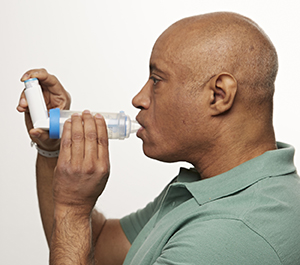Asthma Medicine
Asthma Medicine

Medicines play a key role in controlling asthma. Some help prevent asthma symptoms from getting worse or prevent flare-ups. Others are used to treat symptoms when they occur. Always take your medicine as prescribed. Know the names of your medicines and how and when to use them. If you have any questions about your medicines, talk with your healthcare provider or pharmacist.
Quick-relief medicine
Quick-relief (also called rescue) medicines work by relaxing the muscles around the airways. This helps ease symptoms such as coughing, wheezing, and shortness of breath. Keep your quick-relief inhaler with you at all times. Quick-relief medicines:
-
Are inhaled when needed and only when needed. Use your quick-relief medicine when you first notice your asthma is getting worse.
-
Start to open the airways within a few minutes after you use them.
-
Can help stop a flare-up once it has begun.
-
May be used before exercise as directed by your healthcare provider.
Long-term control medicine
Long-term control (also called maintenance or controller) medicines help reduce airway swelling and inflammation. Some keep the muscles around your airways relaxed. This makes the airways less sensitive to triggers and less likely to flare up. Long-term control medicines:
-
Are taken on a schedule. For most people, this is every day. They are taken even when you feel fine.
-
Help keep asthma under control so you’re less likely to have symptoms.
-
Will not stop a flare-up once it has begun.
Inhaled corticosteroids
Inhaled corticosteroids are generally safe for long-term use. They often don't cause serious side effects. That’s because they’re inhaled directly into the bronchial tubes in your lungs to open the airways. The chance of minor side effects can be lowered even more if you:
-
Use a spacer with your inhaler. Ask your healthcare provider or pharmacist about using a spacer if you don't currently use one.
-
Rinse your mouth, gargle, and spit out the water after using your inhaled corticosteroid medicine.
-
Follow all instructions for cleaning inhalers and spacers.
-
Work with your provider to find the lowest dose that controls your asthma.
Tips for taking medicine
Remembering to take medicine each day can be hard for anyone. It can be even harder to remember when you don’t have symptoms. Try these tips:
-
Create a routine. For example, take long-term controllers as part of getting ready for bed, before you brush your teeth in the morning, or both.
-
Make sure you understand what long-term controllers do and don’t do.
-
Refill your prescriptions on time, or even ahead of time, so you don’t run out.
-
Carry your quick-relief medicine with you. If you can, keep a spare quick-relief inhaler at work, at school, or in your gym bag.
-
When you travel, make sure you have enough medicine to last for your entire trip.
-
When traveling by air, keep your medicines with you, not packed in your luggage.
-
Make sure you know how to tell if your inhaler is empty. Ask your provider or pharmacist. Or check the instructions that come with your inhaler.
Working with your healthcare provider
By working with your healthcare provider, you can get the most benefit from your medicine. Talk with your provider about:
-
Getting the right dose. Over time, your healthcare provider may raise or lower the dose of your controller medicine. The goal is to find the amount of medicine to keep asthma in control, without taking more than is needed.
-
Finding the right medicines for you. Each person is unique. It may take a few tries to find the right medicine or combination of medicines for you. If one medicine doesn’t work well for you, another may work better.
-
Reducing side effects. If you have side effects, don’t just stop taking your medicine. Instead, call your healthcare provider. A new medicine or change in the amount of medicine may solve the problem.
Updated:
May 26, 2019
Sources:
Elward, KS. Medical Therapy for Asthma: Updates from the NAEPP Guidelines. American Family Physician. 82 (10). pp 1242-51.
Reviewed By:
Alan J Blaivas DO,Daphne Pierce-Smith RN MSN CCRC,Daphne Pierce-Smith RN MSN CCRC